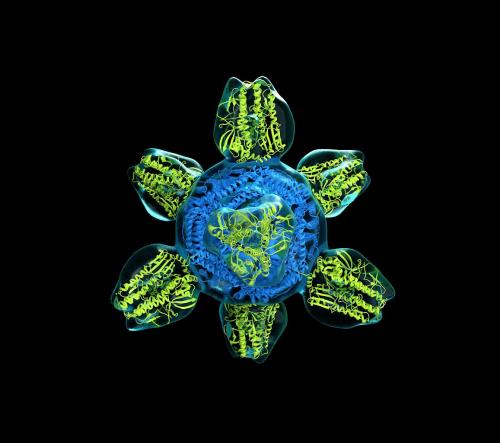Scientists review influenza vaccine research progress and opportunities
In a new series of articles, experts in immunology, virology, epidemiology, and vaccine development detail efforts to improve seasonal influenza vaccines and ultimately develop a universal influenza vaccine.

Colorized structure of a prototype for a universal flu vaccine. The nanoparticle is a hybrid of a protein scaffold (blue) and eight influenza hemagglutinin proteins on the surface (yellow).
In an introductory article, the experts underscore the public health need for improved influenza vaccines, noting the approximately 291,000 to nearly 646,000 deaths worldwide each year due to seasonal influenza. They also discuss the possibility of another influenza pandemic, which occurs when a novel influenza virus to which most people do not have immunity arises unpredictably. The 1918 influenza pandemic caused an estimated 50 million to 100 million deaths.
The current seasonal influenza vaccine reduces influenza-related hospitalizations and deaths. However, people must get vaccinated annually due to constantly changing influenza viruses, and in some years, the vaccine confers less-than-optimal protection against infection. The experts note that recent scientific advances, combined with scientists’ efforts to coordinate and accelerate their research activities, have provided unprecedented momentum toward developing a so-called “universal” influenza vaccine. Such a vaccine would offer long-term protection against multiple seasonal and pandemic influenza viruses.
The supplement articles detail ongoing research and what remains to be learned about influenza—such as how the human immune system responds to influenza infection and vaccination. Experts also discuss how such research might influence vaccine design approaches and help the public health community better prepare for the next influenza pandemic.
In closing remarks, the experts note, “Vaccinology is experiencing a revolution thanks to scientific and technological breakthroughs of the past decade, and hopefully we can find the resolve, political will, and new business plans to take full advantage of these new opportunities and prepare ourselves before the next pandemic arrives.”
Source: U.S. National Institutes of Health
- 344 reads
Human Rights
Fostering a More Humane World: The 28th Eurasian Economic Summi

Conscience, Hope, and Action: Keys to Global Peace and Sustainability

Ringing FOWPAL’s Peace Bell for the World:Nobel Peace Prize Laureates’ Visions and Actions

Protecting the World’s Cultural Diversity for a Sustainable Future

Puppet Show I International Friendship Day 2020

